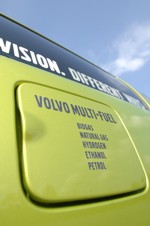

Photographs can be seen in our Volvo Gallery
Introducing the Volvo Multi-Fuel – a high performance prototype car, optimised for running on five different fuels
10 June 2006
As part of their aim at finding different ways to sustainable mobility, Volvo Car Corporation has developed a system for a multitude of fuels. The Volvo Multi-Fuel is a prototype car, optimised for running on five different fuel types; hythane, biomethane, natural gas, bioethanol E85 and petrol. Hythane consists of 10% hydrogen and 90% methane, a blend that has tested most effective for this system.
Optimised for five different fuels
The Volvo Multi-Fuel is a five-cylinder, 2.0-litre prototype car (200
bhp) that runs on five different fuels; hythane (10% hydrogen and 90% methane),
biomethane, natural gas (CNG), bioethanol E85 (85% bioethanol and 15% petrol)
and petrol. The new concept is introduced at the Michelin Challenge Bibendum
2006 and is one of its kind.
The whole car is optimised for high performance, driving on any of the five
different fuels, says Mats Morén, Project Leader Engine at Volvo Car
Corporation.
The Multi-Fuel is just as safe as all Volvo vehicles, with the added bonus of
being exceptionally clean. One of its benefits is that combustion of pure
renewable fuels like hydrogen, biomethane and bioethanol gives negligible net
contribution of fossil carbon dioxide.
It is a first step towards a hydrogen powered society, says Mats Morén. Perhaps we can develop the system even further, to run on a higher blend in the future.
Independent of local infrastructure
Volvo Car Corporation believes that the road to the future is not one but many.
No renewable fuel type can alone replace the fossil fuels of today. Since local
conditions vary, different markets need engines for different alternative fuels,
together with cleaner conventional ones. With this in mind, Volvo Car
Corporation has developed the Multi-Fuel, a prototype car that can be powered by
five different fuel types, thus be driven on the energy source at hand –
anywhere in the world.
The idea is to make use of the fuels that are produced locally, says Mats Morén. This means that less fuel needs to be transported between continents, and you can fill up the car on the fuel that is available wherever you are.
Reinforced gaseous fuel tank
The Multi-Fuel vehicle contains one large and two smaller tanks of
totally 98 litres for gaseous fuels (hythane, biomethane and CNG), and one
29-litre tank for liquid fuels (bioethanol E85 and petrol).
The small gaseous fuel tanks are made of steel, whereas the large tank has a durable, gas tight aluminium liner, reinforced with high performance carbon fibre composite and an exterior layer of hardened fibre-glass composite, says Mats Morén.
The fuel tanks are fitted neatly under the luggage compartment floor, which means that full loading capacity is preserved. Two fuel fillers are used to fill up all five fuel types, one for gaseous and one for liquid fuels. The engine automatically adjusts itself to the right blend of gaseous or liquid fuels. To switch between fuel types, the driver simply presses a button.
High performance on any fuel with maintained
fuel-efficiency
The whole Multi-Fuel vehicle – the engine, the tanks, the transmission and the
fuel system – is optimised for the five different fuels. It can be started
directly on gas, which is unique for this system. The Multi-Fuel has a motor
effect of 200 bhp and accelerates quickly up to speed, 0–100 km/h in 8.7
seconds. This makes the car more responsive and smooth to drive.
The Multi-Fuel is turbo charged to achieve high performance on any of the five different fuel types, says Mats Morén. That makes it great fun to drive and we are very proud of its performance.
Low regulated and unregulated emissions
The Multi-Fuel is remarkably clean and meets the emission standards
for Euro 4 and the proposed levels for Euro 5. An alternative catalyst system
has also been developed to meet the tough demands on extremely low tailpipe
emissions for PZEV/SULEV on the US market. The vehicle has two catalysts, one
close coupled to the engine that lowers initial start emissions, and one under
the floor for reduced high-speed emissions. The double catalysts and advanced
engine control system lead to very low emissions. High-temperature materials in
the exhaust manifold and turbo allow extremely high exhaust gas temperatures of
up to 1050 °C. This enables the car to run cleaner, accelerate quicker and
operate smoother at higher speed.
I love this concept, says Mats Morén, a turbo charged engine with high performance, low fuel consumption and low emissions. On top of that it has a brilliant tank installation and can be run on a multitude of fuels – all wrapped in one beautiful car.
Click to enlarge
Legal | Privacy | Contact Us | Search | Site Map
Volvo Owners' Club Limited® 1962-2025


